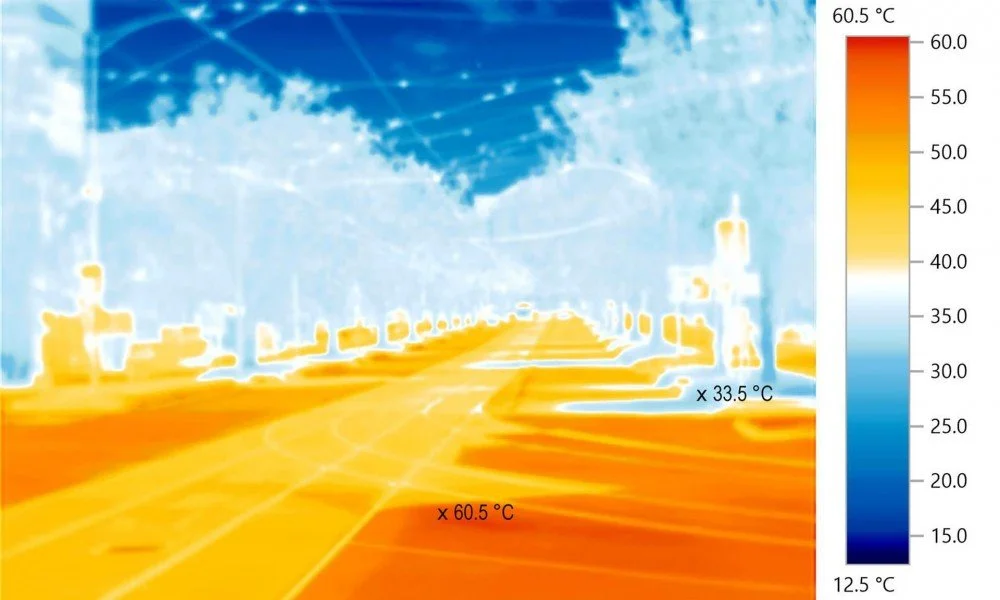The Urban Heat Island Has a Culprit: Concrete. Here’s the Fix.
Introduction: The Urban Heat Island Crisis
Urban heat islands (UHIs) are no longer an academic curiosity; they are a global crisis. Cities worldwide are experiencing rising night-time temperatures, which worsen air quality, intensify health risks, and drive energy demand. The culprit is clear: impervious, heat-trapping surfaces like concrete.
The Economic Toll of UHIs
UHIs are more than an environmental burden; they are a drag on local economies. Research from the International Journal of Environmental Research and Public Health shows that UHIs can raise citywide cooling energy demand by up to 30%. The EPA estimates that reducing UHI effects could save U.S. cities billions annually in avoided energy costs.
Health impacts are equally costly. Heat-related illness leads to lost productivity, higher healthcare spending, and disproportionate impacts on vulnerable populations. The business community increasingly recognizes that climate resilience is not optional – it’s a requirement for economic competitiveness.
Concrete’s Role in Heating Cities
Concrete’s thermal properties make it a heat sink. Unlike vegetation or permeable soils, which cool through evapotranspiration, concrete absorbs heat and radiates it long after sunset. In cities where tree cover is limited, this effect can transform summer nights into health hazards.
AquiPor: Cooling Cities with Smarter Surfaces
AquiPor’s porous concrete offers a two-pronged fix:
Cooling through water interaction: By allowing rainfall to infiltrate, AquiPor surfaces facilitate micro-evaporation that cools surrounding air, much like natural soil.
Low-carbon production: By cutting emissions at the point of manufacture, AquiPor addresses climate change at both the local and global scale.
Beyond its cooling benefits, AquiPor delivers structural integrity, pollution filtration, and scalability across urban environments. It’s not just greener, it’s tougher, longer-lasting, and more cost-effective.
The Business Case for Adoption
Cities that invest in AquiPor’s technology gain competitive advantages:
Reduced Flood Damage Risk & Insurance Costs
By allowing stormwater to infiltrate, AquiPor dramatically cuts surface runoff. This lowers the risk of urban flooding and thus reduces claims and premiums associated with water damage insurance.
Over time, cities and developers could see material financial gains in risk mitigation and insurance savings from utilizing permeable surfaces.
Decreased Infrastructure Maintenance and Lifecycle Costs
Traditional concrete surfaces often fail due to cracking, subsidence, and freeze–thaw damage. AquiPor’s interlocking porous design better tolerates these stresses, extending the lifespan of roadbeds and paved surfaces.
With lower maintenance and repair demands, municipalities and developers save on long-term upkeep costs, freeing up budget for other urban priorities.
Regulatory and Incentive Alignment
Increasingly, urban jurisdictions mandate on-site stormwater management, especially in developments and retrofits. AquiPor’s permeable solutions help ensure regulatory compliance, which can streamline approvals and avoid fines or retrofit costs.
Where green incentives or certifications (e.g., LEED, ESG standards) are sought, AquiPor offers quantifiable, credit-able contribution in sustainable design – enhancing marketability and investor appeal.
Enhanced Urban Livability, Property Value, and Health Outcomes
Cooler, greener streets contribute to public health by reducing heat-related illnesses and improving quality of life. In many markets, areas with walkable, attractive infrastructure fetch higher property values.
Projects using AquiPor can thus differentiate themselves by offering a visibly better environment, which resonates with residents, businesses, and developers alike.
Climate Resilience and Brand Leadership
As extreme weather becomes more frequent, cities and firms that invest in resilient materials gain a reputational advantage. AquiPor enables visible leadership in climate adaptation, which bolsters stakeholder trust and future-proofing investments.
Long-term cost benefits also come from avoided climate-related disruptions, such as flood damage or urban overheating, which can otherwise carry a high societal and financial toll.
Conclusion: The Fix Is Here
The urban heat island has a culprit: concrete. But now it also has a fix. AquiPor’s porous, low-carbon technology cools cities, cleans stormwater, and builds resilience. For policymakers, investors, and developers, the choice is not just environmental, it’s economic.
Aquipor is currently raising capital. You can support their mission and get equity in the company by investing today!
Ready to begin your waste-free journey?
Subscribe to our newsletter for more sustainable living tips, or download our eBook to learn how to reduce your waste and live with intention.
Waste Free Home
Want to create a more sustainable home but not sure where to start?
Our Waste Free Home downloadable workbook is your step-by-step guide to reducing waste and living more intentionally.


